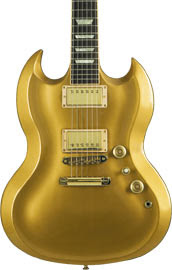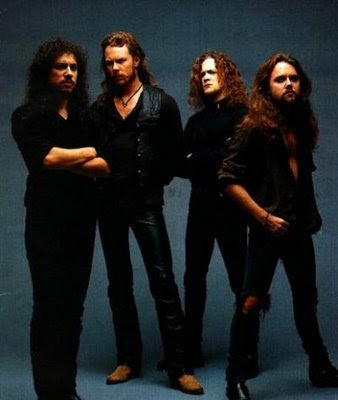
Distortion, also known as overdrive or fuzz, is an effect applied to the electric guitar, the electric bass, and other amplified instruments such as the Hammond organ, synthesizers, and even harmonica and vocals. Accomplished by electronically compressing and/or clipping the input signal, this effect adds sustain and additional harmonics and overtones to the signal, creating a richer sound. The most subtle types of distortion add a "warm" thickness and sustain to the original tone; the more extreme types of distortion range from the noisy, buzzy sound of a late 1960s-era fuzztone pedal to the screaming, "bite", "grit",and "crunch" of a late 1980s thrash-style distortion pedal. Distortion is used across a wide range of musical genres, from the subtle overdrive used in traditional blues to the hard-edged distortion featured in noise music, hardcore punk and metal.
Early examples of distortion were often the result of accidents in which the guitar amplifier or its vacuum valves was damaged, or because the amplifiers and speakers were "doctored" by poking holes into their speaker cones. Observing this trend, Leo Fender of the Fender amplifier company designed valve guitar amps that would "overdrive" slightly.[citation needed] In the 1960s, Jimi Hendrix was one of the first guitarists to experiment with fuzzbox effect pedals.
Distortion can be produced by many components of an instrument's signal path, including effects pedals, the pre-amplifier, power amplifier, speakers, or more recently, digital amplifier modelling devices and software. Many players use a combination of these to obtain their "signature" tone.
History
In the early days of guitar amplification, amplifiers were primitive and low-fidelity, and distortion was inherent in the signal chain. Most amplifiers were all-purpose, designed for use with multiple instruments with different output levels, and guitar pickups were often clip-on types that had weak output levels and microphonic properties. The guitars were typically hollow-body instruments, which would resonate sympathetically with the amplified signal, causing unwanted feedback and an excessive resonant sustain in the bass frequencies. Though electric guitars had been around since 1928 and played popularly by Les Paul and Charlie Christian in the 1930s and 1940s, it was not until the early 1950s that they became commercially successful. It was during this period that the first solid-bodied electric guitars became widely available; they did not suffer as badly from feedback as earlier models, hence they could be played at higher output levels.
The idea of intentionally using distortion to improve the amplified tone had not occurred to early amplifier makers. Early examples of distortion were often the result of accidents in which the guitar amplifier was in some way damaged, but the player or producer decided they liked it and recorded it that way. During the recording of "Rocket 88", one of the early rock and roll songs, Ike Turner and the Kings of Rhythm guitarist Willie Kizart used an amplifier that had been damaged in transit, resulting in an early recorded example of guitar distortion. For the recording of "The Train Kept A-Rollin'" by the Johnny Burnette Trio, a valve fell out of the amplifier during a live performance. When a reviewer then raved about the crazy new sound, Burnette used the same tone in the recording studio.[1]
An early user of valve overdrive was Chuck Berry, who at the start of his career played through small valve amplifiers, the only ones he could afford. Because of their low output, they were easy to overdrive, giving Chuck's guitar tone a warm overdriven sound, which can be heard on his recording of his first hit "Maybellene". On later recordings he was able to afford better and larger amps and consequently his tone became cleaner. The earliest uses of intentional distortion that have been recorded were achieved through "doctoring" amplifiers and speakers. Guitarists would use a razor blade, screwdriver or pencil to poke holes into their speaker cones to create a distorted sound.[2]
Leo Fender of Fender guitars and amplifiers observed these trends and engineered many of his amplifiers to "compress" and or "overdrive" slightly without drastically distorting the signal. The early Fender "Tweed" and "Blackface" amplifiers are considered a good example of clean electric guitar tone. Many later amplifiers are based on these designs. Significantly, Jim Marshall of Marshall Amplifiers copied the Fender Bassman using parts available in the United Kingdom, creating an amplifier with significant overdrive that quickly caught on in the local music scene and laid the foundation for the powerful, thick "Marshall Sound" that can be heard on so many early heavy metal albums. Later, distortion and fuzz effects were achieved through electronics. Jimi Hendrix was one of the first guitarists to use outboard effects, many designed or modified by guitar tech Roger Mayer.








 Power Tab Editor is a tablature authoring tool for the Windows operating system. It is intended to be used to create guitar sheet music, more commonly known to musicians as guitar tablature and bass tablature. (aka guitar tab/bass tab). The program provides the most commonly used
Power Tab Editor is a tablature authoring tool for the Windows operating system. It is intended to be used to create guitar sheet music, more commonly known to musicians as guitar tablature and bass tablature. (aka guitar tab/bass tab). The program provides the most commonly used 





